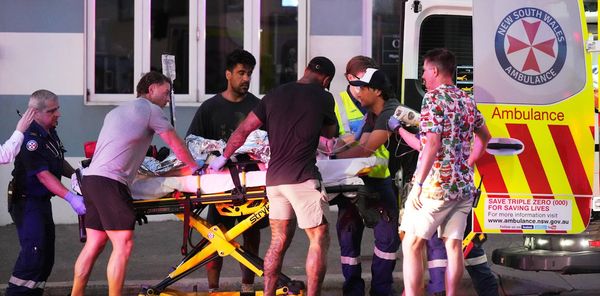
Rescuers and marine conservationists have rushed to Tasmania’s west coast as efforts continue to save pilot whales after a mass stranding near the remote town of Strahan.
On Wednesday, a pod of about 230 pilot whales became stranded on Ocean beach, west of Strahan. Some were also stranded on a sand flat inside Macquarie harbour, south of the town. At least 100 of the animals are thought to have died.
The event occurred a day after another mass stranding on King Island, in Bass Strait, where 14 sperm whales died and washed ashore.

The Tasmanian Department of Natural Resources and Environment said on Wednesday a team from the department’s marine conservation program was assembling whale rescue gear and arriving in the area.
“Marine wildlife experts will assess the scene and the situation to plan an appropriate response,” it said. “Stranding response in this area is complex. If it is determined there is a need for help from the general public, a request will be made through various avenues.”
The department is being assisted by staff from the Tasmania Parks and Wildlife Service and Tasmania police. Additional personnel, including a vet, were still arriving after dark last night.
The separate stranding earlier this week on King Island, to the north of Tasmania, saw 14 male sperm whales die. A necropsy was carried out and tissue samples sent for analysis.
Australia’s worst whale stranding on record occurred in the same location exactly two years ago. On 21 September 2020, 470 pilot whales were found beached – a week-long rescue effort saved 111 of them, but authorities subsequently had to dispose of more than 350 carcasses.
Tom Mountney, who attended the 2020 mass stranding, was among the first rescuers to arrive at the beach on Wednesday, and said the scene on a calm day was “surreal”.
With colleagues from Petuna Aquaculture, Mountney had been using special blankets to turn the whales over in the hope some could be pulled out to sea.

Sam Gerrity, of Southwest Expeditions, who also attended the scene, said the weather conditions meant rescuing the animals on Ocean beach would be logistically difficult. “There’s still about four to five metres of swell, so they just keep getting washed further and further up the beach,” he said.
Gerrity, who was also involved in the logistical operation after the 2020 mass stranding, added: “A lot of them are starting to die.”
Prof Karen Stockin, an expert on whale and dolphin strandings at Massey University in New Zealand, confirmed from video and pictures that the species in peril were pilot whales.
She said Tasmania’s west coast was a global hotspot for pilot whale strandings. There could be multiple causes, but she said it could be related to cyclical changes in ocean temperatures that may have pushed prey closer to shore.
She added: “In pilot whales, they are highly social and cohesive and if one is debilitated or comes too close to shore, hundreds can follow.”
Dr Vanessa Pirotta, a wildlife scientist affiliated with Macquarie University, said it would be “a very sobering situation down there” for rescuers. “These animals use sound to talk to each other, they’ll be able to hear these whales calling out to each other in stress, and that is heartbreaking.”
Pirotta said the reasons for cetacean strandings remain a mystery. “Because this has been the same species, same location, same time, is it the case that there might be something environmental about the area – misnavigation or a topography hazard,” she said. “It could also be a sick individual that may have led the whole pod astray.”
Pilot whales are a misnamed large oceanic dolphin and are known as the most susceptible cetacean species to mass strandings.
The species that became stranded in 2020 were long-finned pilot whales that feed on squid and fish and can dive to 1km and hold their breath for 30 minutes.
Experts have said the species can form temporary “super-pods” of up to 1,000 animals. Females can live beyond 40 years old and some individuals spend their entire life in the same pod.







